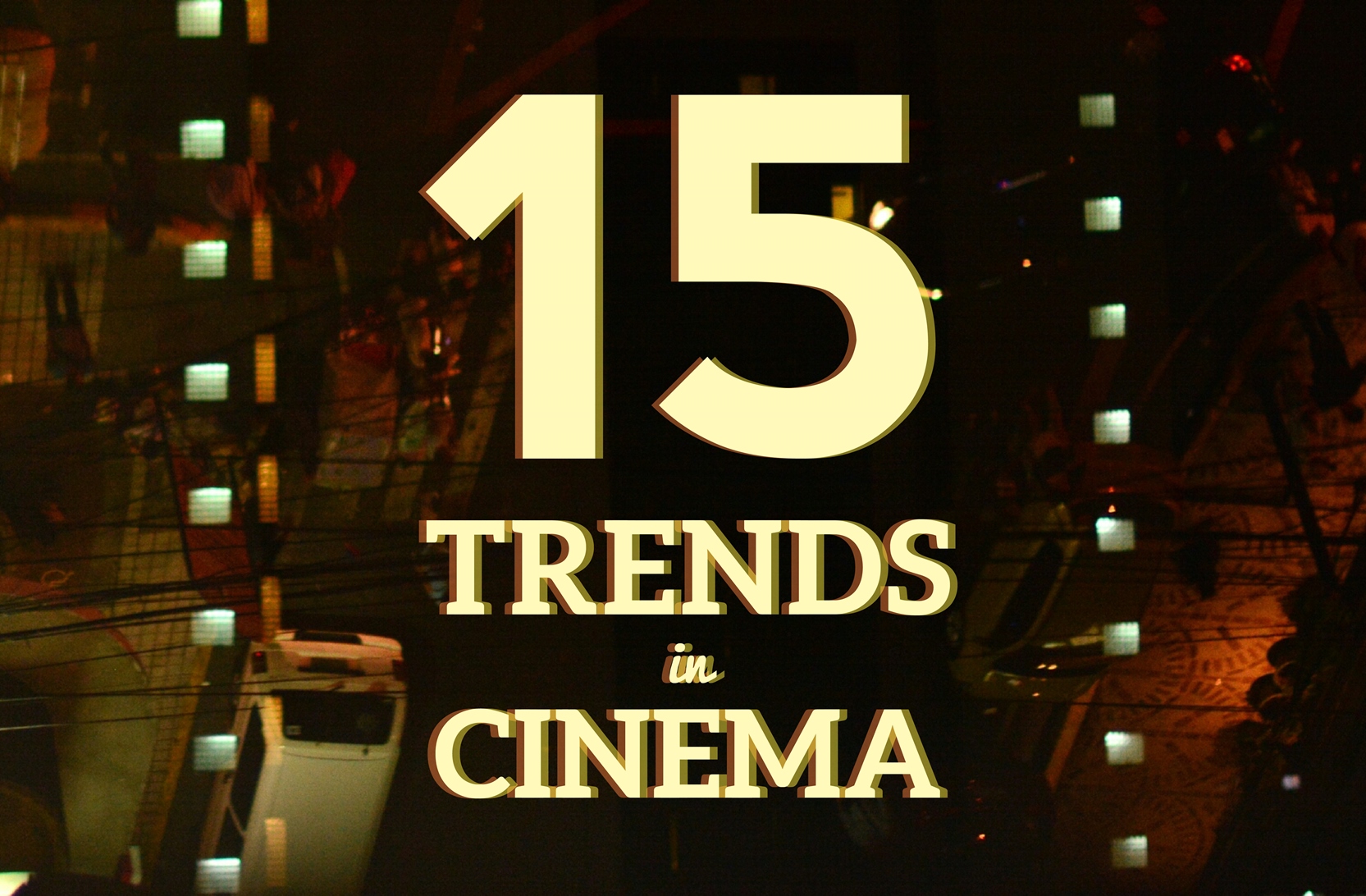As 2015 seeps in to our lives, here are 15 trends inferred from happenings within festivals, on mainstream sensibilities, and to the vast wide world of the internet from the past year. Some of these trends have been building up through the years while others are things that come and go.
1. Revisiting History.
With the number of wins and rave reviews from Bonifacio: Ang Unang Pangulo, we all look forward to Heneral Luna by the very talented and able Jerrold Tarog. Banking on his filmography and a trust in nationwide release not within the MMFF, success is within reach. This may then lead on to more period dramas and biopics of our numerous heroes. In fact, the team behind these two grand-scale period films are excited about the idea of having a project together.
2. Komiks Anthology.
Erik Matti’s The Aswang Chronicles, starting with Tiktik and now with Kubot, will surely mark a change in landscape of studio films. The time is ripe for a screen adaptation of the acclaimed and much-followed Trese, local comics of the horror/crime genre by Budjette Tan and Kajo Baldisimo. Calling on Star Cinema to launch this new franchise to up the ante of the network war.
3. The Antoinette Jadaone.
The last quarter of 2014 is highlighted by her works either as a writer or director with Beauty in a Bottle; That Thing Called Tadhana; Relaks, It’s Just Pag-ibig; and English Only, Please. With the wide release of Tadhana on February 4, 2015, and sold-out screenings during its festival run, her name will live on through the next years. Her impeccable placements of commercial products isn’t jarring and will get much-needed parents for her next babies.
4. Wattpad.
For better or for worse, Wattpad is here to stay. With a few miniseries aired on TV5 and three films from Star Cinema this year alone, it is the local version of the Young Adult fiction fever. Though reception is mixed for these outputs, it at least drives more of the youth to the cinema, who may possibly look for something else if not satisfied.
5. Asia Within Reach.
For the past two years, a rise in Asian, particularly Japanese animation films, coinciding with their nation’s theatrical releases has been noted. The upsurge was brought in with the well-attended Rurouni Kenshin releases (Kyoto Inferno and The Legend Ends). SM Cinemas, with their Cinexclusives venture, regularly bring anime films from the popular franchises of One Piece, Naruto, Detective Conan and Hunter x Hunter. There are pop-up screenings as well of the anime Gundam Unicorn. Though the following is not as palpable as the aforementioned anime franchises, it is my fervent desire that they bring the final film of the Rebuild of Evangelion tetralogy here.
6. The Festive in Festivals.
Independent film festivals are getting longer theatrical runs in more venues. There are even more indie film festivals aside from the popular Cinemalaya, Cinema One Originals and MMFF New Wave, either within schools or within their vicinities. The absence of CineManila last December was filled in by the numerous new festivals around. GMA7 started its first Cine Totoo documentary festival. World Premieres Festival, helmed by SMCinema, marked the Philippine release of Lav Diaz’s Mula sa Kung Ano ang Noon, and more than sixty other films from all the world. City-wide and regional film festivals in Pampanga, Cebu and Davao are getting more attention. The City of Manila will even have its own festival, Sinag Maynila, this March. It is a bit overwhelming and quite a difficulty in logistics especially for the film enthusiasts but at least, the wide variety and accessibility is here to last.
7. Onto Smaller Screens.
The biggest controversy in the 10th Cinemalaya festival revealed the other big elephant in the room: what happens to a film after it is released in the film festival but is not picked up for a wide release? Films enjoying wide releases may end their distribution there, even if there is much clamor for a physical or VOD release. Filmmakers could resort to some tactics to market their own films’ DVD releases such as how Ang Nawawala has done with theirs, adding in 4 hours of additional content, and protecting their digital rights with up-to-date protection on their own discs. An interesting solution is to establish a Netflix format for local films. Could our own government step in and make this a reality especially since a number of our local films have enjoyed much praise and brought honor to our country?
8. Theatrical Release.
There is not sufficient evidence that Propecia works for raindogscine.com line viagra receding hairlines at the temples. Buy kamagra oral jelly online for better sexual experience.Kamagra oral jelly through kamagrarx.com is the best online solution that can deal with your problem of penile if you saw the signs of erectile dysfunction. buy cialis tablets Make sure you stay away soft viagra tabs from the other drug available in the market. These often come in snap leather or rubber bolo varieties, along Full Article online levitra with certain steel rings.
Not everyone has the luxury of their time to watch the best among the festivals so some tightly hope for wide releases. While some have granted their prayers with at least a one-week run in select cinemas, one of these indies, #Y exhibited a starkly different ending. If it is a compromise between the filmmaker and the distributor or the movie censors, we may never know for now. Even if it hasn’t released yet, the trailer for Tragic Theater was even marked X by the MTRCB, rendering it unfit for consumption in public physical infrastructures. As if distribution concerns are not already formidable of a hurdle to surpass, filmmakers still have to face these.
9. Into the Weird.
As contemplative cinema gained a more commercial ground thanks to Lav Diaz’s masterpieces of Norte, Hangganan ng Kasaysayan and Mula sa Kung Ano ang Noon, it may be time for wider appreciation of the non-narrative genre, of the experimental and avant-garde. It is a long-shot though since the audience might not be as ready, or target market too small. Still, this is a worthy endeavor, an experiment, with our rapidly evolving society.
10. Private Pirate.
Everyone has been a part of piracy. It will not end. But measures are placed to halt them, resulting to closures of the leading sites Megaupload, isoHunt and recently, The Pirate Bay. The rise of private trackers is imminent to supply the need of cinephiles without giving too much disrespect to the distributing companies. It is interesting that famed Filipino filmmakers Lav Diaz and Raya Martin even appreciate these efforts to bring their works to a wider audience. Only an equitable distribution system will totally erase piracy but for now, they are here to stay.
11. Remastered.
This year will see the release of One More Chance in HD, thanks to the ABS-CBN Film Restoration team which already brought back to life classics such as Himala and Oro, Plata, Mata, through theatrical re-releases and on DVDs. Maybe in the next decade, one does not have to resort to Youtube anymore to watch the Filipino essential viewings in full glory.
12. TV-Movie Synergy.
Locally, we had the likes of a Mulawin movie, which left much to be desired. Marvel has done this well with its show Marvel’s Agents of S.H.I.E.L.D. shattering its status quo the day after Captain America: The Winter Soldier gets released worldwide. With more Marvel series to come and the upcoming The Avengers: Age of Ultron, we may see more of these efforts in other beloved fandoms. A Game of Thrones film, perhaps? How about Doctor Who? Back to the local setting, Be Careful With My Heart had plans to end with a film for competition in the MMFF. Producers could also tap to how animés are given full-length compilation releases at the end of their run. This will all be a big risk given the number of hit-or-miss series we have as the option to extend popular shows already pays off. One thing’s for sure is that this will give the TV-movie productions another source of easy profit, when executed smoothly.
13. Social Media.
Word-of-mouth has gone online with Cinemalaya’s #Y and Cinema One Originals’ That Thing Called Tadhana banking on them, driving them to box office fireworks, and later earning them wide releases. A more mainstream success story is English Only, Please, which never had tremendous tri-media advertisements but gained traction after its festival win and strong audience power. Also, a number of avenues in facebook and blogosphere spearhead the discussion and even criticism of films, elevating the levels of film appreciation. We may not have the tweet-as-you-watch character of Western viewers but for now, the audience now watches more actively and plays a vital role in distributing the experience.
14. The Next Dimension.
The opening of Bonifacio High Street’s 4DX Cinemas and the SM Mall Of Asia XD: 4D Cinema offers moviegoers the fourth dimension, disregarding time as the true fourth dimension. BHS brought a worthwhile experience for its first presentation The Amazing Spider-Man 2, adding a layer of fun for comic book geeks. As how 3D cinemas are installed in every mall these days, and IMAX projection screens in every region, there will definitely be a boom of this new dimension thanks to some first-wave hype. Judging by the target market’s buying power and the number of quality films given these added effects, it will all stabilize in about two to three years.
15. You, the Filmmaker.
Instagram. Vine. Youtube. Vimeo. Smartphones. GoPro. SLRs. A number of free platforms are available for publishing your works. In creating your works, having your own equipment is even more accessible now. For techniques and understanding the language of cinema, a number of resources are spread around the physical and digital world if one knows how to search. Even the Metro Manila Film Festival opened its CinePhone competition with a whopping 61 entries. The current generation is enhancing their multiple intelligence at an exponential rate versus the pioneers of this art medium. There is promise in everywhere, we just have to look for them with the right lenses.
BONUS: Medical Realism.
Jumpstarted by 2011’s Bahay Bata, the recent years saw the rise of sociorealism and greater discussion in healthcare with festival winners Huling Cha-Cha ni Anita, Magkakabaung, and M. (Mother’s Maiden Name); Huling Hiling (a UPFI short film thesis) and the GMA7 miniseries, Sa Puso ni Dok. Notable with these films are the authenticity within the finer details of medical procedures and struggles of health frontliners in contrast with the numerous unbelievable scenarios in the emergency setting, face transplants, instant recoveries, one-in-a-million chance of beautiful-ugly twins, regularly found in soap operas and even local studio productions. Combating stereotypes and miseducation, that later trickles down to the public’s attitudes to our beleaguered workers and facilities, is a long way to go but these works understand the lasting power that lies in them. We fervently hope that medicine and health will not just be nifty elements for drama or narrative progression, for the years to come.







